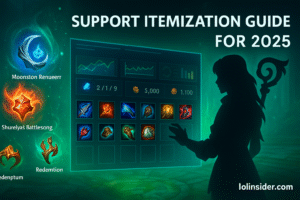Behind every superstar in esports is a story of discovery. Faker, Rekkles, Scout, and Chovy were once unknown names grinding ranked or dominating local tournaments before esports orgs noticed them. Today, the scouting process is far more advanced than it was a decade ago.
In 2025, how esports orgs scout new talent is a blend of traditional observation, data analytics, community tournaments, and structured amateur ecosystems. This article takes a deep dive into how organizations identify, evaluate, and develop the next generation of professional players — and what it means for aspiring pros.
1. The Evolution of Esports Scouting
Early Days
- Relied on word of mouth and local events.
- Players were discovered mostly by climbing the solo queue ladder.
- Teams often picked based on raw mechanics, ignoring teamwork.
Modern Era (2020s → 2025)
- Structured amateur ecosystems (Academy/ERL/Challenger circuits).
- Data-driven scouting tools analyze performance across thousands of games.
- Orgs employ dedicated scouting staff similar to traditional sports.
2. Where Orgs Look for New Talent
2.1 Solo Queue Ladder
- Why it matters: High solo queue ranks (Challenger/Grandmaster) showcase raw mechanics.
- How it’s used: Scouts look for standout players with high win rates and consistent performance.
- Limitations: Doesn’t always measure communication, teamwork, or mentality.
2.2 Amateur & Semi-Pro Leagues
- Examples: European Regional Leagues (ERLs), LCS Challengers, collegiate circuits.
- Why it matters: Provides structured team play experience.
- Scouting focus: How players perform in 5v5 environments with coaches and strategies.
2.3 Tournaments & Showcases
- Online events (Scouting Grounds, Twitch Rivals, collegiate tournaments).
- Offline LANs for amateur teams.
- Allow scouts to see performance under pressure.
2.4 Streaming & Content Creation
- Many orgs notice players through Twitch or YouTube.
- Charisma and fan engagement are secondary but valuable traits.
3. The Role of Data and Analytics
Performance Metrics
- KDA, CS per minute, vision score, damage share.
- Consistency across patches.
- Champion pool diversity.
Advanced Tools
- Orgs use platforms like Mobalytics, ProView, or custom analytics dashboards.
- AI-powered systems highlight undervalued talent hidden in the rankings.
Why Analytics Matters
- Reduces bias in scouting.
- Identifies diamonds in the rough (e.g., players who may not stream but dominate statistically).
4. Scouting Combines & Tryouts
Some orgs host scouting combines — structured events where players perform drills, scrims, and interviews.
What Scouts Evaluate:
- Mechanical Skill: Execution in drills and scrims.
- Communication: Shotcalling, clarity, and teamwork.
- Mentality: Tilt control, resilience after mistakes.
- Adaptability: Ability to learn new metas quickly.
Example: Riot’s NA Scouting Grounds gave orgs direct access to top solo queue talent.
5. Traits Scouts Value Beyond Mechanics
- Game Sense: Map awareness, objective control, macro decisions.
- Adaptability: Can they perform on multiple champions and styles?
- Communication: Clear, calm, and effective comms.
- Work Ethic: Willingness to grind, review VODs, and accept coaching.
- Mental Resilience: Ability to handle pressure from stage play.
6. Case Studies: Famous Discoveries
Faker (T1)
- Found dominating Korean solo queue.
- Scouts recognized his mechanics + decision-making beyond numbers.
Rekkles (Fnatic)
- Spotted in amateur EU tournaments.
- His consistency and discipline made him a prime candidate.
Closer (Golden Guardians/100T)
- Rose from Turkish scene to NA LCS via strong ERL performances.
Gumayusi (T1)
- Originally overlooked, but org scouts noticed his mechanics in practice.
7. Challenges in Scouting
- Overhyping Solo Queue Stars: Some lack teamwork or mentality.
- Regional Disadvantages: Talented players in smaller regions get less visibility.
- Burnout Risk: Young players may crumble under pressure after promotion.
- Cultural Fit: Skill alone doesn’t guarantee success in team environments.
8. Development After Scouting
Once scouted, players rarely jump straight into top teams. Most orgs use tiered systems:
- Academy/Challenger Teams: Train under supervision.
- Scrim Integration: Practice with the main roster.
- Stage Exposure: Slowly introduced to pro matches.
- Brand Development: Some are trained for streaming and fan interaction.
9. The Role of Esports Agents
Like traditional sports, agents now connect rising talent with orgs.
- Negotiate contracts.
- Provide career guidance.
- Help players avoid exploitation.
This professionalization ensures scouting is fairer and more structured than in the early days.
10. The Future of Esports Scouting
Looking ahead to 2025 and beyond:
- AI-Driven Scouting: Machine learning predicts player growth curves.
- Global Databases: Unified platforms for tracking every competitive match.
- Psychological Testing: Measuring resilience and leadership potential.
- Expanded Amateur Ecosystems: More structured leagues worldwide.
Conclusion
How esports orgs scout new talent has evolved from word of mouth to a multi-layered system combining solo queue, amateur leagues, analytics, tryouts, and personality evaluation.
For aspiring pros, the formula is clear:
- Climb solo queue.
- Compete in structured tournaments.
- Show adaptability, teamwork, and mental resilience.
Esports scouting today is as professional as traditional sports — and the next Faker or Caps might already be grinding quietly in solo queue, waiting for their chance to be discovered.







